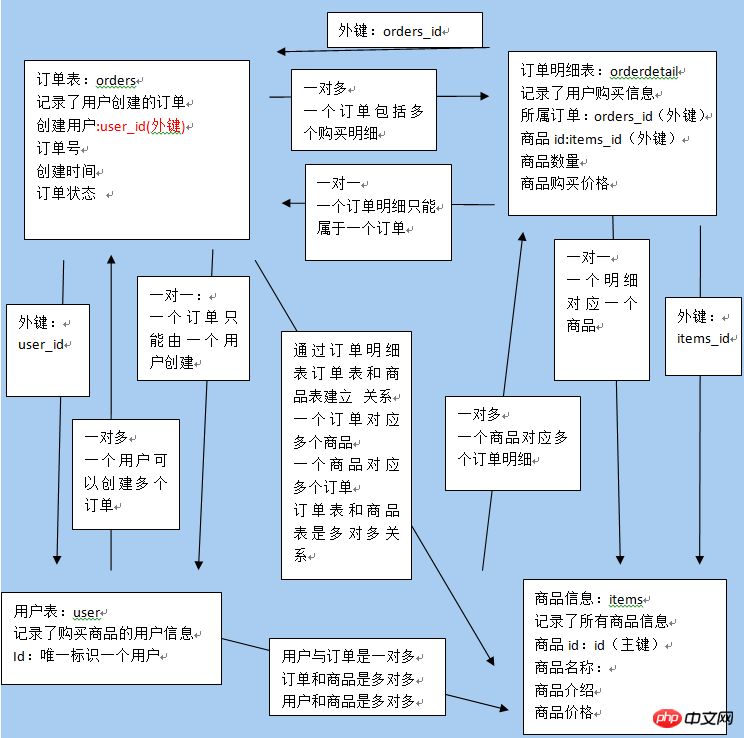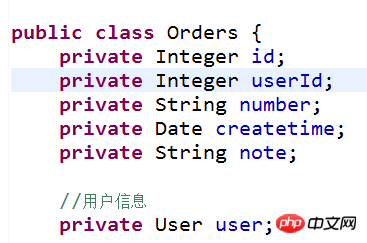MyBatis關聯查詢的實例教程
- 零下一度原創
- 2017-06-25 10:34:331688瀏覽
轉載請註明出處:
前面有將到:Spring+SpringMVC+MyBatis深入學習及搭建(五)——動態sql
#1.商品訂單資料模型

1.1資料模型分析想法
(1)每張表記錄的資料內容
分模組對每張表記錄的內容進行熟悉,相當於你學習系統需求(功能)的過程。
(2)每張表格重要的欄位設定
非空白欄位、外鍵欄位
(3)資料庫層級表與表格之間的關係
外鍵關係
(4)表與表之間的業務關係
在分析表與表之間的業務關係時,一定要建立在某個業務意義基礎上去分析。
1.2屬性模型分析

2.一對一查詢
2.1需求
查詢訂單信息,關聯查詢下單用戶資訊。
2.2方法一:resultType
2.2.1sql語句
確定查詢的主表:訂單表
確定查詢的關聯表:使用者表
關聯查詢使用內連結?還是外鏈結?
由於orders表中有一個外鍵(user_id),透過外鍵關聯查詢使用者表只能查詢出一筆記錄,可使用內連結。
SELECT orders.*, USER.username, USER.sex, USER.address FROM orders, USER WHERE orders.user_id = user.id
2.2.2建立pojo
將上邊sql查詢的結果對應到pojo中,pojo中必須包含所有查詢列名。
原始Orders.java無法對應全部字段,需要新建立pojo。
建立一個pojo繼承包含查詢欄位較多的pojo類別。

2.2.3mapper.xml
<?xml version="1.0" encoding="UTF-8"?><!DOCTYPE mapper
PUBLIC "-//mybatis.org//DTD Mapper 3.0//EN"
"http://mybatis.org/dtd/mybatis-3-mapper.dtd"><!--namespace命名空间,作用就是对sql进行分类化的管理,理解为sql隔离
注意:使用mapper代理开发时,namespace有特殊作用,namespace等于mapper接口地址 --><mapper namespace="joanna.yan.mybatis.mapper.OrdersCustomMapper"><!--查询订单,关联查询用户信息 --><select id="findOrdersUser" resultType="joanna.yan.mybatis.entity.OrdersCustom">SELECT
orders.*,
USER.username,
USER.sex,
USER.address
FROM
orders,
USER
WHERE orders.user_id = user.id</select></mapper>2.2.4mapper.java
public interface OrdersCustomMapper {//查询订单,关联查询用户信息public List<OrdersCustom> findOrdersUser() throws Exception;
}2.2.5測試程式
@Testpublic void findOrdersUserTest() throws Exception{
SqlSession sqlSession=sqlSessionFactory.openSession();
OrdersCustomMapper ordersCustomMapper=sqlSession.getMapper(OrdersCustomMapper.class);
List<OrdersCustom> list=ordersCustomMapper.findOrdersUser();
System.out.println(list);
sqlSession.close();
}2.3方法二:resultMap
2.3.1sql語句
同resultType實作的sql

2.3.2使用resultMap映射的想法
使用resultMap將查詢結果中的訂單資訊對應到Orders物件中,在Orders類別中新增User屬性,將關聯查詢出來的使用者資訊映射到orders物件中的user屬性。
2.3.3需要orders類別中新增user屬性

2.3.4mapper.xml
2.3.4.1定義resultMap
<!--订单关联查询用户的resultMap
将整个查询的结果映射到oanna.yan.mybatis.entity.Orders中 --><resultMap type="joanna.yan.mybatis.entity.Orders" id="OrdersUserResultMap"><!-- 1.配置映射的订单信息 --><!-- id:指定查询列中的唯一标识,订单信息中的唯一标识,如果有多个列组成唯一标识,配置多个id
column:订单信息中的唯一标识列
property:订单信息中的唯一标识列所映射到Orders类中的哪个属性 --><id column="id" property="id"/><result column="user_id" property="userId"/><result column="number" property="number"/><result column="createtime" property="createtime"/><result column="note" property="note"/><!-- 2.配置映射的关联的用户信息 --><!-- association:用于映射关联查询单个对象的信息
property:要将关联查询的用户信息映射到Orders类中的哪个属性 --><association property="user" javaType="joanna.yan.mybatis.entity.User"><!-- 关联查询用户的唯一标识
column:指定唯一标识用户信息的列
property:映射到user的哪个属性 --><id column="user_id" property="id"/><result column="username" property="username"/><result column="sex" property="sex"/><result column="address" property="sex"/></association></resultMap>
2.3.4.2定義statement定義
<!--查询订单,关联查询用户信息,使用ResultMap --><select id="findOrdersUserResultMap" resultMap="OrdersUserResultMap">SELECT orders.*, USER.username, USER.sex, USER.address FROM orders, USER WHERE orders.user_id = user.id</select>
2.3.4.3mapper.java
public interface OrdersCustomMapper {//查询订单,关联查询用户信息,使用resultMappublic List<Orders> findOrdersUserResultMap() throws Exception;
}2.3. 4.4測試程式
@Testpublic void findOrdersUserResultMapTest() throws Exception{
SqlSession sqlSession=sqlSessionFactory.openSession();
OrdersCustomMapper ordersCustomMapper=sqlSession.getMapper(OrdersCustomMapper.class);
List<Orders> list=ordersCustomMapper.findOrdersUserResultMap();
System.out.println(list);
sqlSession.close();
}2.4 resultType和resultMap實作一對一查詢小結
實作一對一查詢:
resultType:使用resultType實作較為簡單,如果pojo中沒有包含查詢出來的列名,則需要增加列名對應的屬性,即可完成對應。
如果沒有查詢結果的特殊要求,建議使用resultType。
resultMap:需要單獨定義resultMap,實作有點麻煩,如果對查詢結果又特別的要求,使用resultMap可以完成將關聯查詢映射pojo的屬性中。
resultMap可以實現延遲加載,resultType無法實現延遲加載。
3.一對多查詢
3.1需求
查詢訂單及訂單明細的資訊
#3.2sql語句
確定主查詢表:訂單表
決定關聯查詢表:訂單明細表
在一對一查詢基礎上新增訂單明細表關聯即可。
SELECT orders.*, USER.username, USER.sex, USER.address, orderdetail.id orderdetail_id, orderdetail.items_id, orderdetail.items_num, orderdetail.orders_idFROM orders, USER, orderdetailWHERE orders.user_id = user.id AND orderdetail.orders_id=orders.id
3.3分析
使用resultType將上邊的查詢結果對應到pojo中,訂單資訊的就會重複。
要求:
對orders的對應不能出現重複記錄。
解決:
在Orders.java類別中加入List
最終會將訂單資訊對應到Orders中,訂單所對應的訂單明細會對應到orders中的orderDetails屬性中。
對應成的orders記錄數為兩個(orders資訊不重複)
每個orders中的orderDetails屬性儲存了該訂單所對應的訂單明細。
3.4在Orders類別中新增list訂單明細屬性

3.5定義resultMap
<!--订单及订单明细的resultMap
使用extends继承,就不需要再配置订单信息和用户信息的映射了 --><resultMap type="joanna.yan.mybatis.entity.Orders" id="OrdersAndOrderDetailResultMap" extends="OrdersUserResultMap"><!-- 1.配置映射的订单信息 --><!-- 2.配置映射的关联的用户信息 --><!-- 使用extends继承,就不需要再配置订单信息和用户信息的映射了 --><!-- 3.配置映射的订单明细信息 --><!-- 订单明细信息
一个订单关联查询出了多条明细,要使用collection进行映射
collection:对关联查询到的多条记录映射到集合对象中
property:将关联查询到多条记录映射到joanna.yan.mybatis.entity.Orders中的哪个属性
ofType:指定映射到list集合属性中pojo的类型 --><collection property="orderdetails" ofType="joanna.yan.mybatis.entity.Orderdetail"><!-- id:订单明细的唯一标识
property:要讲订单明细的唯一标识映射到joanna.yan.mybatis.entity.Orderdetail的哪个属性 --><id column="orderdetail_id" property="id"/><result column="items_id" property="itemsId"/><result column="items_num" property="itemsNum"/><result column="orders_id" property="ordersId"/></collection></resultMap>3.6mapper. xml
<!-- 查询订单,关联查询用户及订单明细,使用resultMap --><select id="findOrdersAndOrderDetailResultMap" resultMap="OrdersAndOrderDetailResultMap">SELECT orders.*, USER.username, USER.sex, USER.address, orderdetail.id orderdetail_id, orderdetail.items_id, orderdetail.items_num, orderdetail.orders_id FROM orders, USER, orderdetail WHERE orders.user_id = user.id AND orderdetail.orders_id=orders.id</select>
3.7mapper.java
public interface OrdersCustomMapper {//查询订单,关联查询用户信息public List<OrdersCustom> findOrdersUser() throws Exception;//查询订单,关联查询用户信息,使用resultMappublic List<Orders> findOrdersUserResultMap() throws Exception;//查询订单(关联用户)及订单明细public List<Orders> findOrdersAndOrderDetailResultMap() throws Exception;
}3.8測試程式
@Testpublic void findOrdersAndOrderDetailResultMapTest() throws Exception{
SqlSession sqlSession=sqlSessionFactory.openSession();
OrdersCustomMapper ordersCustomMapper=sqlSession.getMapper(OrdersCustomMapper.class);
List<Orders> list=ordersCustomMapper.findOrdersAndOrderDetailResultMap();
System.out.println(list);
sqlSession.close();
}3.9小结
mybatis使用resultMap的collection对关联查询的多条记录映射到有个list集合属性中。
使用resultType实现:
将订单明细映射到orders中的orderdetails中,需要自己处理,使用双重循环遍历,去掉重复记录,将订单明细放在ordertails中。
4.多对多查询
4.1需求
查询用户及用户购买的商品信息。
4.2sql语句
查询主表:用户表
关联表:由于用户和商品没有直接关联,通过订单和订单明细进行关联,所有关联表:orders、orderdetail、items。
SELECT orders.*, USER.username, USER.sex, USER.address, orderdetail.id orderdetail_id, orderdetail.items_id, orderdetail.items_num, orderdetail.orders_id, items.name items_name, items.detail items_detail, items.price items_priceFROM orders, USER, orderdetail, itemsWHERE orders.user_id = user.id AND orderdetail.orders_id=orders.id AND orderdetail.items_id = items.id
4.3映射思路
将用户信息映射到user中。
在User类中添加订单列表属性List
在Orders中田间订单明细列表属性List
在OrderDetail中添加Items属性,将订单明细所对应的商品映射到Items。
4.4 mapper.xml
<select id="findUserAndItemsResultMap" resultMap="UserAndItemsResultMap">SELECT orders.*, USER.username, USER.sex, USER.address, orderdetail.id orderdetail_id, orderdetail.items_id, orderdetail.items_num, orderdetail.orders_id, items.name items_name, items.detail items_detail, items.price items_price FROM orders, USER, orderdetail, items WHERE orders.user_id = user.id AND orderdetail.orders_id=orders.id AND orderdetail.items_id = items.id </select>
4.5定义resultMap
<!-- 查询用户及购买商品 --><resultMap type="joanna.yan.mybatis.entity.User" id="UserAndItemsResultMap"><!-- 1.用户信息 --><id column="user_id" property="id"/><result column="username" property="username"/><result column="sex" property="sex"/><result column="address" property="address"/><!-- 2.订单信息 --><!-- 一个用户对应多个订单,使用collection映射 --><collection property="ordersList" ofType="joanna.yan.mybatis.entity.Orders"><id column="id" property="id"/><result column="user_id" property="userId"/><result column="number" property="number"/><result column="createtime" property="createtime"/><result column="note" property="note"/><!-- 3.订单明细 --><!-- 一个订单包括多个明细 --><collection property="orderdetails" ofType="joanna.yan.mybatis.entity.Orderdetail"><id column="orderdetail_id" property="id"/><result column="items_id" property="itemsId"/><result column="items_num" property="itemsNum"/><result column="orders_id" property="ordersId"/><!-- 4.商品信息 --><!-- 一个订单明细对应一个商品 --><association property="items" javaType="joanna.yan.mybatis.entity.Items"><id column="items_id" property="id"/><result column="items_name" property="name"/><result column="items_detail" property="detail"/><result column="items_price" property="price"/></association></collection></collection></resultMap>
4.6mapper.java
public interface OrdersCustomMapper {//查询订单,关联查询用户信息public List<OrdersCustom> findOrdersUser() throws Exception;//查询订单,关联查询用户信息,使用resultMappublic List<Orders> findOrdersUserResultMap() throws Exception;//查询订单(关联用户)及订单明细public List<Orders> findOrdersAndOrderDetailResultMap() throws Exception;//查询用户购买商品信息public List<User> findUserAndItemsResultMap() throws Exception;
}4.7测试程序
@Testpublic void findUserAndItemsResultMapTest() throws Exception{
SqlSession sqlSession=sqlSessionFactory.openSession();
OrdersCustomMapper ordersCustomMapper=sqlSession.getMapper(OrdersCustomMapper.class);
List<User> list=ordersCustomMapper.findUserAndItemsResultMap();
System.out.println(list);
sqlSession.close();
}4.8多对多查询总结
将查询用户购买的商品信息明细清单(用户名、用户地址、购买商品名称、购买商品时间、购买商品数量)
针对上面的需求就使用resultType将查询到的记录映射到一个扩展的pojo中,很简单实现明细清单的功能。
一对多是多对多的特例,如下需求:
查询用户购买的商品信息,用户和商品的关系是多对多关系。
需求1:
查询字段:用户账号、用户名称、用户性别、商品名称、商品价格(最常见)
企业开发中常见明细列表,用户购买商品明细列表,
使用resultType将上边查询列映射到pojo输出。
需求2:
查询字段:用户账号、用户名称、购买商品数量、商品明细(鼠标移上显示明细)
使用resultMap将用户购买的商品明细列表映射到user对象中。
总结:
使用resultMap是针对那些对查询结果映射有特殊要求的功能,比如特殊要求映射成list中包含多个list。
5.resultMap总结
resultType:
作用:将查询结果按照sql列名pojo属性一致性映射到pojo中。
场合:
常见一些明细记录的展示,比如用户购买商品明细,将关联查询信息全部展示在页面时,此时可直接使用resultType将每一条记录映射到pojo中,在前端页面遍历list(list中是pojo)即可。
resultMap:
使用association和collection完成一对一和一对多高级映射(对结果又特殊的映射要求)。
association:
作用:将关联查询信息映射到一个pojo对象中。
场合:
为了方便查询关联信息可以使用association将关联订单信息映射为用户对象的pojo属性中,比如:查询订单及关联用户信息。
使用resultType无法将查询结果映射到pojo对象的pojo属性中,根据对结果集查询遍历的需要选择使用resultType还是resultMap。
collection:
作用:将关联查询信息映射到一个list集合中。
场合:为了方便擦还行遍历关联信息可以使用collection将关联信息映射到list集合中,比如:查询用户权限范围模块及模块下的菜单,可使用collection将模块映射到模块list中,将菜单列表映射到模块对象的菜单list属性中,这样做册目的也是方便对查询结果集进行遍历查询。
如果使用resultType无法将查询结果映射到list集合中。
以上是MyBatis關聯查詢的實例教程的詳細內容。更多資訊請關注PHP中文網其他相關文章!


